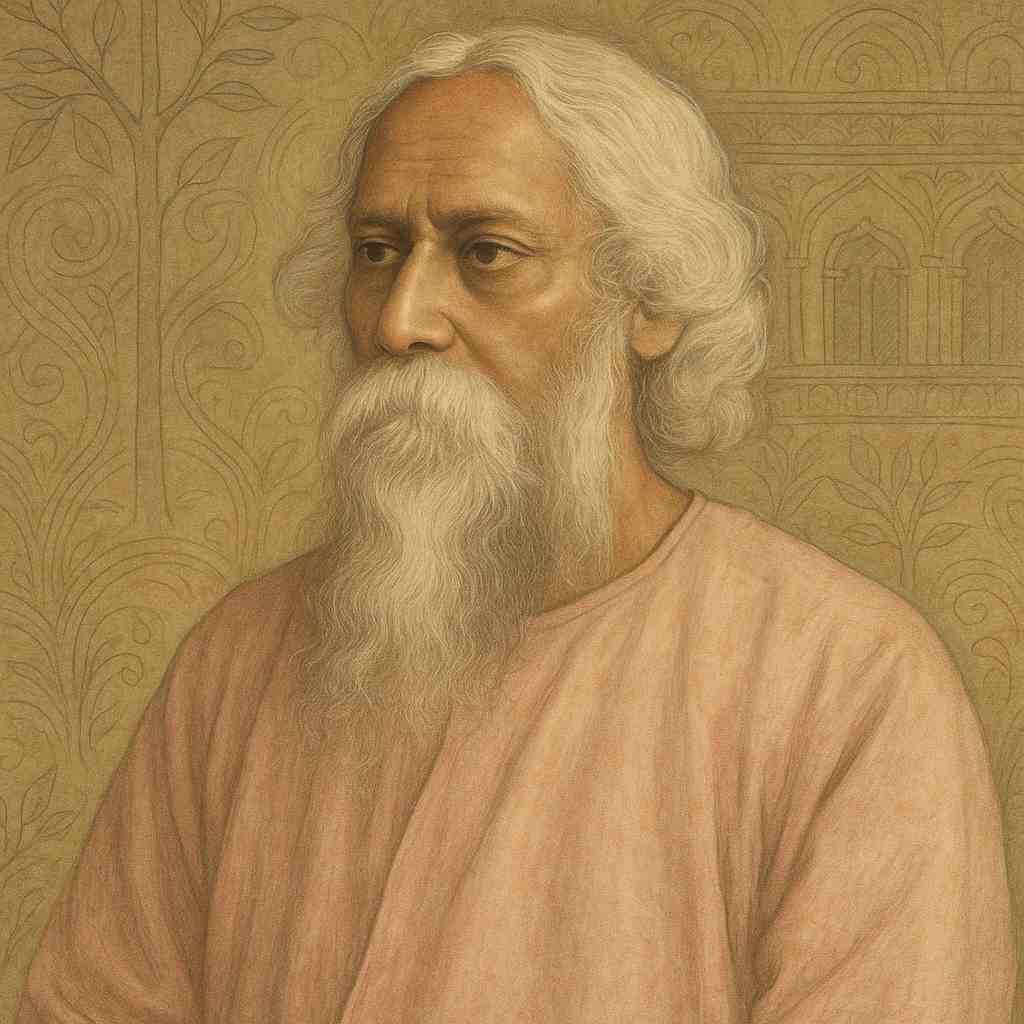Let Me Not Forget
Rabindranath Tagore
1861 to 1941

If it is not my portion to meet thee in this life
then let me ever feel that I have missed thy sight
- let me not forget for a moment,
let me carry the pangs of this sorrow in my dreams
and in my wakeful hours.
As my days pass in the crowded market of this world
and my hands grow full with the daily profits,
let me ever feel that I have gained nothing
- let me not forget for a moment,
let me carry the pangs of this sorrow in my dreams
and in my wakeful hours.
When I sit by the roadside, tired and panting,
when I spread my bed low in the dust,
let me ever feel that the long journey is still before me
- let me not forget a moment,
let me carry the pangs of this sorrow in my dreams
and in my wakeful hours.
When my rooms have been decked out and the flutes sound
and the laughter there is loud,
let me ever feel that I have not invited thee to my house
- let me not forget for a moment,
let me carry the pangs of this sorrow in my dreams
and in my wakeful hours.
Rabindranath Tagore's Let Me Not Forget
Rabindranath Tagore's poem "Let Me Not Forget" is a poignant exploration of spiritual longing and the human desire for divine connection. Through its four stanzas, the poem weaves a tapestry of emotions, combining elements of devotion, melancholy, and unwavering faith. The speaker's voice resonates with a deep sense of yearning for an encounter with the divine, referred to as "thee" throughout the piece.
The poem's structure is notable for its repetition, with each stanza concluding with the same three lines: "- let me not forget for a moment, / let me carry the pangs of this sorrow in my dreams / and in my wakeful hours." This refrain serves as a powerful anchor, emphasizing the speaker's commitment to maintaining awareness of their spiritual quest, even in the face of life's distractions. The repetition also creates a meditative quality, reminiscent of prayer or mantra, reinforcing the poem's spiritual undertones.
In the first stanza, Tagore introduces the central theme of unfulfilled spiritual longing. The speaker acknowledges the possibility of not meeting the divine in this lifetime, yet expresses a fervent desire to remain cognizant of this absence. The use of the word "pangs" to describe the sorrow is particularly evocative, suggesting a physical, visceral experience of spiritual yearning. This sets the tone for the rest of the poem, establishing the depth and intensity of the speaker's devotion.
The second stanza contrasts the spiritual realm with the material world. The imagery of the "crowded market" and "daily profits" represents the mundane aspects of life that often distract from spiritual pursuits. Despite achieving worldly success, the speaker insists on feeling that they have "gained nothing," highlighting the perceived emptiness of material accomplishments in comparison to spiritual fulfillment. This stanza underscores the challenge of maintaining spiritual focus in a world driven by material concerns.
In the third stanza, Tagore employs the metaphor of a journey to represent the spiritual quest. The speaker, depicted as tired and resting by the roadside, acknowledges that the "long journey is still before me." This imagery suggests that the path to spiritual enlightenment or divine union is arduous and ongoing. The humility expressed in spreading one's bed "low in the dust" further emphasizes the speaker's devotion and willingness to endure hardship in pursuit of their spiritual goal.
The final stanza presents a scene of celebration and joy, with decorated rooms, music, and laughter. However, even in this moment of apparent happiness, the speaker feels the absence of the divine, having "not invited thee to my house." This poignant contrast highlights the incompleteness of worldly pleasures without spiritual fulfillment. It also suggests that true joy can only be achieved through divine presence.
Throughout the poem, Tagore masterfully balances the tension between worldly experiences and spiritual aspirations. The speaker's unwavering commitment to remembering their spiritual longing, even in moments of rest, work, or celebration, demonstrates a profound dedication to the spiritual path. This persistence in the face of life's distractions and temptations is presented as a form of spiritual practice in itself.
The use of second-person address, referring to the divine as "thee," creates an intimate tone and suggests a personal relationship between the speaker and the divine. This intimacy contrasts with the sense of separation and longing that permeates the poem, creating a complex emotional landscape that reflects the nuanced nature of spiritual experience.
Tagore's poem also touches on themes of impermanence and the transient nature of human life. The acknowledgment that meeting the divine might not occur "in this life" implies a belief in something beyond the current existence, possibly hinting at reincarnation or an afterlife. This adds a layer of philosophical depth to the poem, inviting readers to contemplate their own beliefs about life, death, and spiritual connection.
In conclusion, "Let Me Not Forget" is a profound meditation on spiritual longing and the human condition. Through its evocative imagery, repetitive structure, and deeply emotional language, Tagore crafts a universal message about the challenges and rewards of maintaining spiritual awareness in a material world. The poem's enduring appeal lies in its ability to articulate the complex emotions associated with spiritual seeking, resonating with readers across cultural and religious boundaries. It stands as a testament to Tagore's skill in exploring the depths of human spirituality and his enduring influence on both Eastern and Western literary traditions.
This text was generated by AI and is for reference only. Learn more
Want to join the discussion? Reopen or create a unique username to comment. No personal details required!



Comments
No comments yet. Be the first to comment!